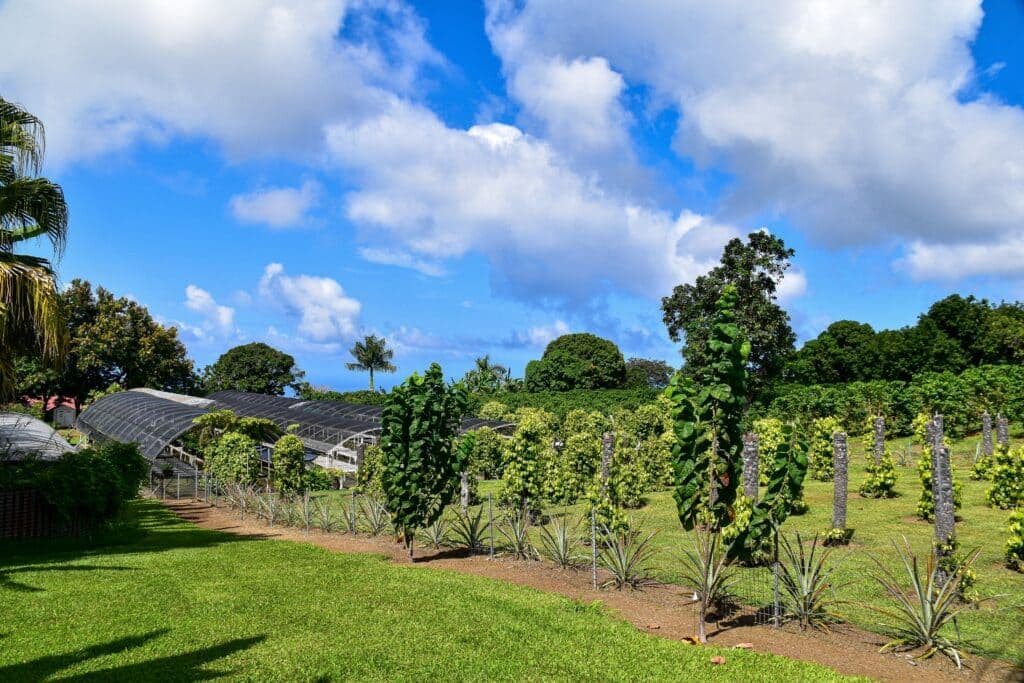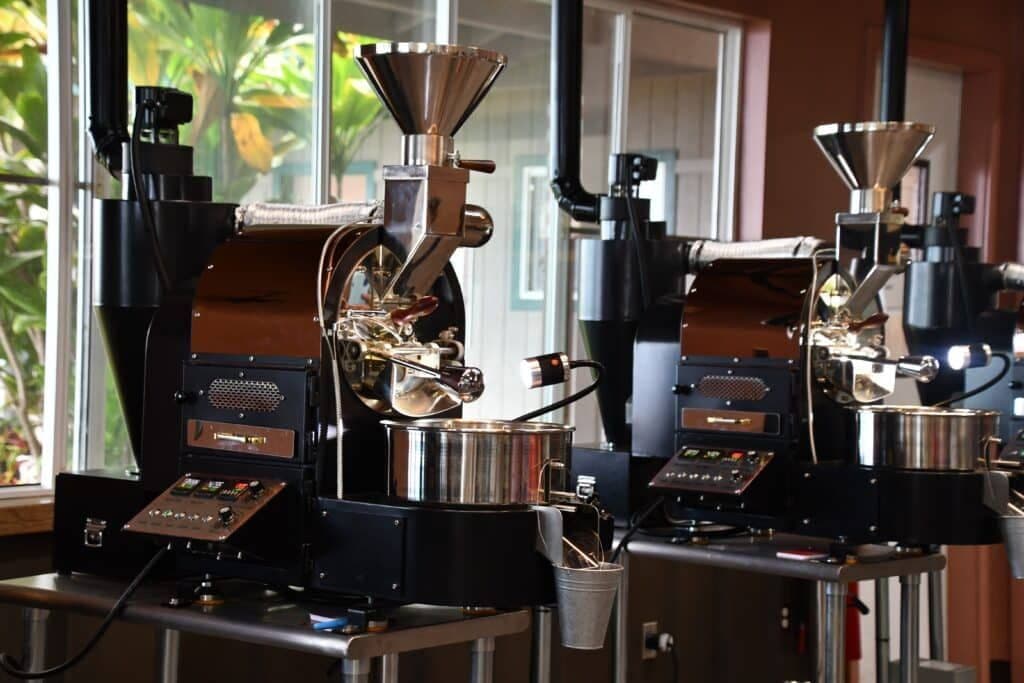By Stephanie Namahoe Launiu

Raw coffee beans (Shutterstock)
Renowned for its rich flavor and smooth finish, Kona Coffee Hawaii is cultivated on the slopes of Hualālai and Mauna Loa in Hawai‘i’s Kona region. The area’s unique climate and volcanic soil create ideal conditions for coffee cultivation, making it a prime destination for java enthusiasts.
In the Kona District on the Island of Hawai‘i, the Mauna Loa volcanoes play a crucial role in creating the unique climatic and soil conditions that make Kona Coffee so exceptional.
An elite coffee industry has grown from this little bean. It’s developed into the “bean known around the world.” What has made Kona Coffee so sought after? What makes it such a special cup to those who crave their daily java?
The growing region for this prized coffee spans just 30 square miles. Thirty square miles? That’s it? Yup — and it’s that limited footprint that makes Kona coffee so rare.
To grow the best beans, elevation is key. The magic happens between 800 and 2,500 feet above sea level. Below that range, Kona’s weather is too hot and dry for healthy crops. And above it? Rainfall increases so much that native rainforests take over, making coffee farming difficult — if not impossible. In those higher elevations, coffee trees would bloom and fruit year-round, disrupting the delicate balance needed to cultivate high-quality beans.
Being a Kona coffee farmer isn’t easy. With such tight constraints on geography and altitude, every cup comes from a place of precision, passion, and perseverance.
If you’re a coffee lover, set aside a little time to tour a Kona Coffee farm and find out exactly what it takes to produce a simple cup of Kona Coffee. Embarking on a Kona coffee tour offers an immersive experience of the art and science of java production.

tropical Kona coffee plantation (Shutterstock)
The story of Kona coffee in Hawai‘i began in 1828, when American missionary Samuel Ruggles planted the first coffee trees in the Kona region. What started as a modest experiment grew into a thriving tradition. Over time, the area blossomed into a coffee-growing haven, with small, family-owned farms dotting the district’s slopes. Today, Kona is home to more than 650 coffee farms. Yes, you read that right — 650+ independent growers,
Each farm adds to the region’s reputation for producing some of the world’s finest coffee. The limited growing area, together with labor-intensive farming methods and high demand, makes 100% Kona Coffee a rare and sought-after commodity.
Kailua-Kona serves as the central hub for exploring the world-renowned Kona Coffee farms, offering a variety of tours and experiences for visitors.
Many farms offer guided tours that demonstrate how they cultivate, process, and roast coffee beans. These tours often end with tastings so that visitors can savor the nuanced flavors of freshly brewed Kona coffee. These are very popular, so you should plan ahead and make reservations to avoid disappointment.
Kona’s mornings are typically sunny, making early tours enjoyable and providing optimal lighting for taking photos. Morning tours are also recommended to see active farm operations happening.
The coffee production cycle in Kona influences the tour experience:
February to March: This period marks the blooming season, often referred to as “Kona Snow,” when coffee trees are adorned with delicate white flowers.
April to August: Green coffee cherries develop during these months, gradually ripening to a deep red.
August to January: Harvesting season occurs, with farms bustling as they pick and process the ripe cherries.
Visitors to the Big Island can choose from a variety of tour options to experience the history and production of Kona coffee. From guided tours of coffee farms to self-guided tours of the coffee fields, there’s something for every coffee lover. Some tours offer a behind-the-scenes look at the roasting process. Others provide an opportunity to learn about the history and culture of Kona coffee.

Kona Joe Coffee Plantation (Shutterstock)
Here are some distinguished local coffee farms that offer engaging tours:
Greenwell Farms: Established in 1850, Greenwell Farms is one of the longest-running coffee producers in Kona. They offer free daily guided tours between 9 a.m. and 3 p.m. without the need for reservations. Visitors can explore the farm’s facilities and enjoy free samples of their coffee varieties.
Hula Daddy Kona Coffee: Known for its award-winning coffee, Hula Daddy offers two morning tours that you can book online, Monday through Friday. For a nominal fee, guests can visit the orchard, learn about specialty coffee cultivation, and participate in a tasting session.
Kona Coffee Living History Farm: Operated by the Kona Historical Society, this open-air museum offers self-guided tours depicting the daily lives of early Japanese immigrants between 1920 and 1945. Visitors can explore the coffee orchard, farmhouse, and coffee mill, gaining a historical perspective on Kona coffee farming.
Heavenly Hawaiian Farms: Offering a variety of tours, including their signature Coffee Farm Tour, Heavenly Hawaiian provides guests with a comprehensive understanding of the coffee production process. Tours include unlimited samples of their best coffees and a visit to their Konalani Coffee Bar.
UCC Hawaii: This 35-acre estate offers guided tours where visitors can learn about coffee cultivation and processing. They also provide a unique Roastmaster Tour™, allowing guests to roast their own coffee beans and create personalized labels.
These farms not only showcase the unique qualities of Hawaiian coffee but also offer a glimpse into the artisanal methods used in its production.
A typical Kona coffee tour encompasses several stages of the coffee production process:
Cultivation: Guides explain the growth cycle of coffee plants, including the significance of the region’s microclimate and volcanic soil.
Harvesting: Depending on the season, visitors may witness or participate in the hand-picking of ripe coffee cherries, a labor-intensive process that ensures quality.
Processing: Tours often demonstrate the methods of pulping, fermenting, and drying the beans, highlighting traditional and modern techniques.
Roasting: Some farms offer insights into the roasting process, showcasing how temperature and timing influence flavor profiles.
Tasting: The culmination and highlight of most tours is a tasting session, where guests can sample various brews and discern the subtle differences.
Coffee plants are an integral part of the Kona coffee farm tour experience. Learn about the different varieties, and how they’re cultivated and harvested. From the coffee cherry to the green coffee bean, visitors can see firsthand the journey of Kona coffee from seed to cup. Many tours also offer the opportunity to participate in the harvesting process, giving visitors a hands-on experience of what it takes to produce high-quality Kona coffee.
No coffee farm tour would be complete without a taste of the best coffee. Visitors can sample a variety of Kona coffees, from light to dark roasts, and learn about the roasting process that brings out the unique flavors of Kona coffee. Many tours also offer a visit to the roasting room, where visitors can see the expert roasters at work and learn about the techniques that go into creating the perfect cup of Kona coffee.
One of the most rewarding aspects of a coffee farm tour is the opportunity to meet the farmers. Their passion for coffee is contagious! From living history coffee farms to the small, family-owned farms, visitors can hear the stories of the people who dedicate their lives to producing high-quality Kona coffee. You’ll feel the aloha spirit of the coffee community. You’ll hear about the hard work and dedication that goes into producing one of the world’s best coffees.
A Kona coffee tour is more than just a tasting experience. It’s an educational journey through the rich history and meticulous process behind one of the world’s most esteemed beverages. It doesn’t matter whether you’re a casual coffee drinker or a connoisseur. Exploring these farms offers a deeper appreciation for the brew and the dedicated individuals who craft it.
Join our newsletter for travel inspiration, insider tips and the latest island stories.
By subscribing, you agree to receive emails from Hawaii.com. You can unsubscribe anytime. See our Privacy Policy.